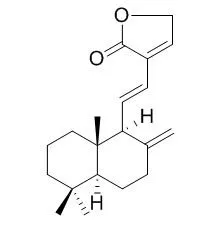| In vitro: |
| Nat Prod Commun. 2014 Jul;9(7):907-10. | | Abietane diterpenoids from Clerodendrum trichotomum and correction of NMR data of Villosin C and B.[Pubmed: 25230490] |
METHODS AND RESULTS:
Nine abietane diterpenoids (1-9) were isolated from the stems of Clerodendrum trichotomum Thunb. and identified by spectroscopic methods. Furthermore, corrected NMR data is provided for Villosin C (1) and B (2) whose absolute configurations were elucidated from circular dichroism (CD) data. All isolates were tested for cytotoxicity against four cancer cell lines (A549, HepG-2, MCF-7 and 4T1).
CONCLUSIONS:
Compounds 1, 2, 3, 4 and 8 were found to have remarkable cytotoxic effects with IC50 values ranging from 8.79 to 35.46 microM. | | Phytother Res. 2010 Jul;24(7):1009-13. | | Labdane-type diterpenes from Hedychium gardnerianum with potent cytotoxicity against human small cell lung cancer cells.[Pubmed: 19960422] |
METHODS AND RESULTS:
Nine abietane diterpenoids (1-9) were isolated from the stems of Clerodendrum trichotomum Thunb. and identified by spectroscopic methods. Furthermore, corrected NMR data is provided for Villosin C (1) and B (2) whose absolute configurations were elucidated from circular dichroism (CD) data. All isolates were tested for cytotoxicity against four cancer cell lines (A549, HepG-2, MCF-7 and 4T1).
CONCLUSIONS:
Compounds 1, 2, 3, 4 and 8 were found to have remarkable cytotoxic effects with IC50 values ranging from 8.79 to 35.46 microM. | | Pharmacogn Rev. 2014 Jul;8(16):101-4. | | Rubus fruticosus (blackberry) use as an herbal medicine.[Pubmed: 25125882] | Wild grown European blackberry Rubus fruticosus) plants are widespread in different parts of northern countries and have been extensively used in herbal medicine.
METHODS AND RESULTS:
The result show that European blackberry plants are used for herbal medicinal purpose such as antimicrobial, anticancer, antidysentery, antidiabetic, antidiarrheal, and also good antioxidant. Blackberry plant (R. fruticosus) contains tannins, gallic acid, Villosin, and iron; fruit contains vitamin C, niacin (nicotinic acid), pectin, sugars, and anthocyanins and also contains of berries albumin, citric acid, malic acid, and pectin. Some selected physicochemical characteristics such as berry weight, protein, pH, total acidity, soluble solid, reducing sugar, vitamin C, total antioxidant capacity, antimicrobial screening of fruit, leaves, root, and stem of R. fruticosus, and total anthocyanins of four preselected wild grown European blackberry (R. fruticosus) fruits are investigated. Significant differences on most of the chemical content detect among the medicinal use.
CONCLUSIONS:
The highest protein content (2%), the genotypes with the antioxidant activity of standard butylated hydroxyanisole (BHA) studies 85.07%. Different cultivars grown in same location consistently show differences in antioxidant capacity. |
|






 Cell. 2018 Jan 11;172(1-2):249-261.e12. doi: 10.1016/j.cell.2017.12.019.IF=36.216(2019)
Cell. 2018 Jan 11;172(1-2):249-261.e12. doi: 10.1016/j.cell.2017.12.019.IF=36.216(2019) Cell Metab. 2020 Mar 3;31(3):534-548.e5. doi: 10.1016/j.cmet.2020.01.002.IF=22.415(2019)
Cell Metab. 2020 Mar 3;31(3):534-548.e5. doi: 10.1016/j.cmet.2020.01.002.IF=22.415(2019) Mol Cell. 2017 Nov 16;68(4):673-685.e6. doi: 10.1016/j.molcel.2017.10.022.IF=14.548(2019)
Mol Cell. 2017 Nov 16;68(4):673-685.e6. doi: 10.1016/j.molcel.2017.10.022.IF=14.548(2019)